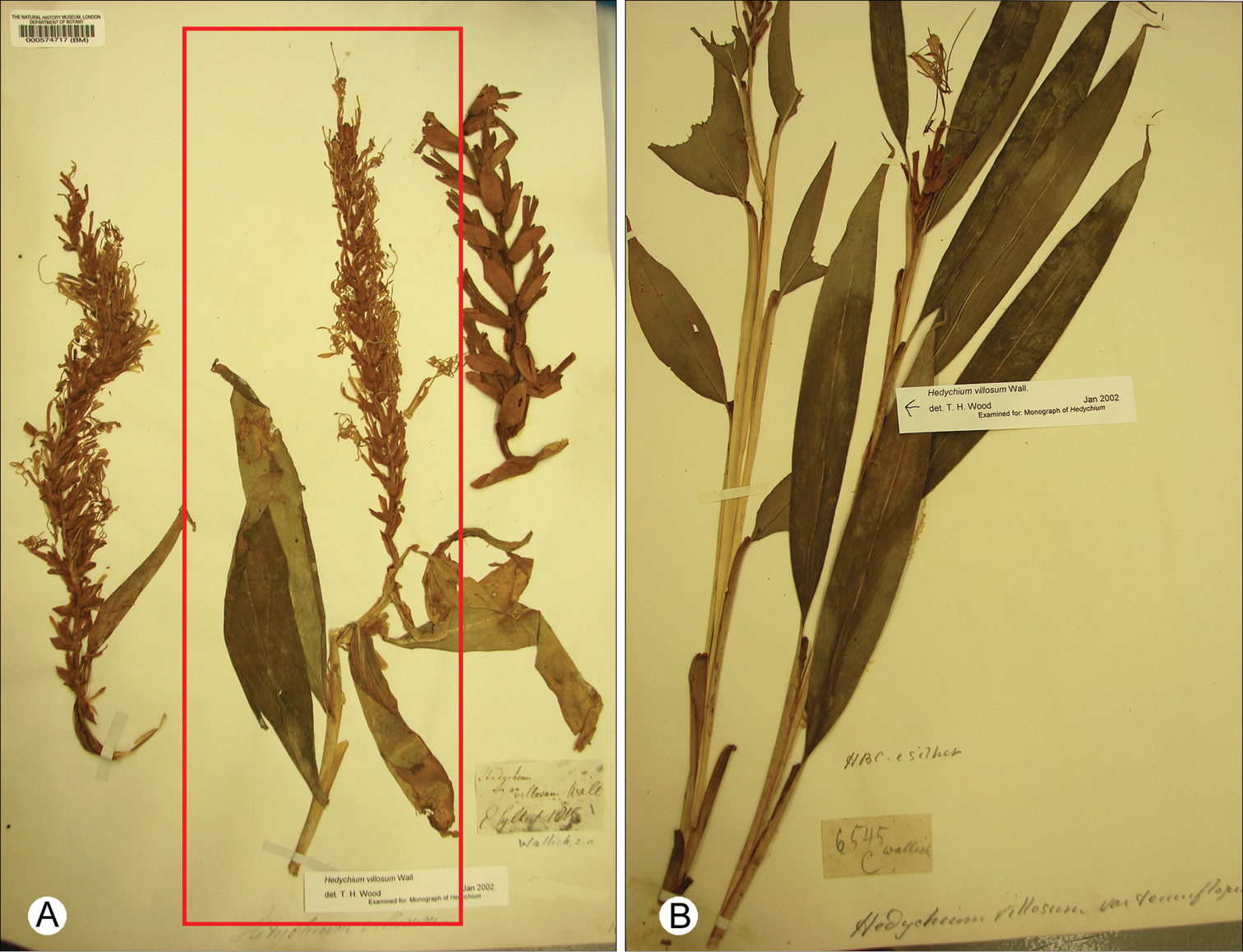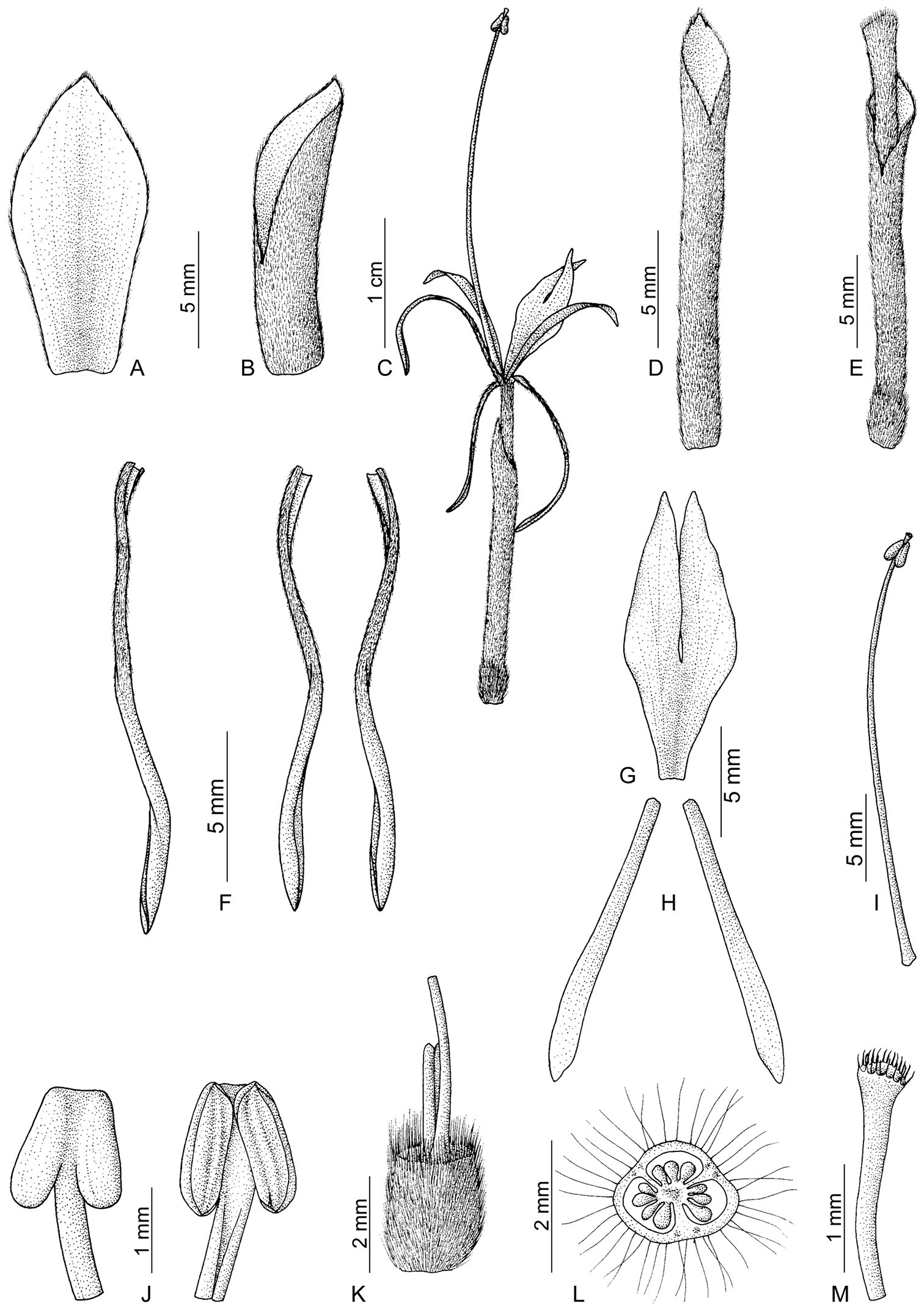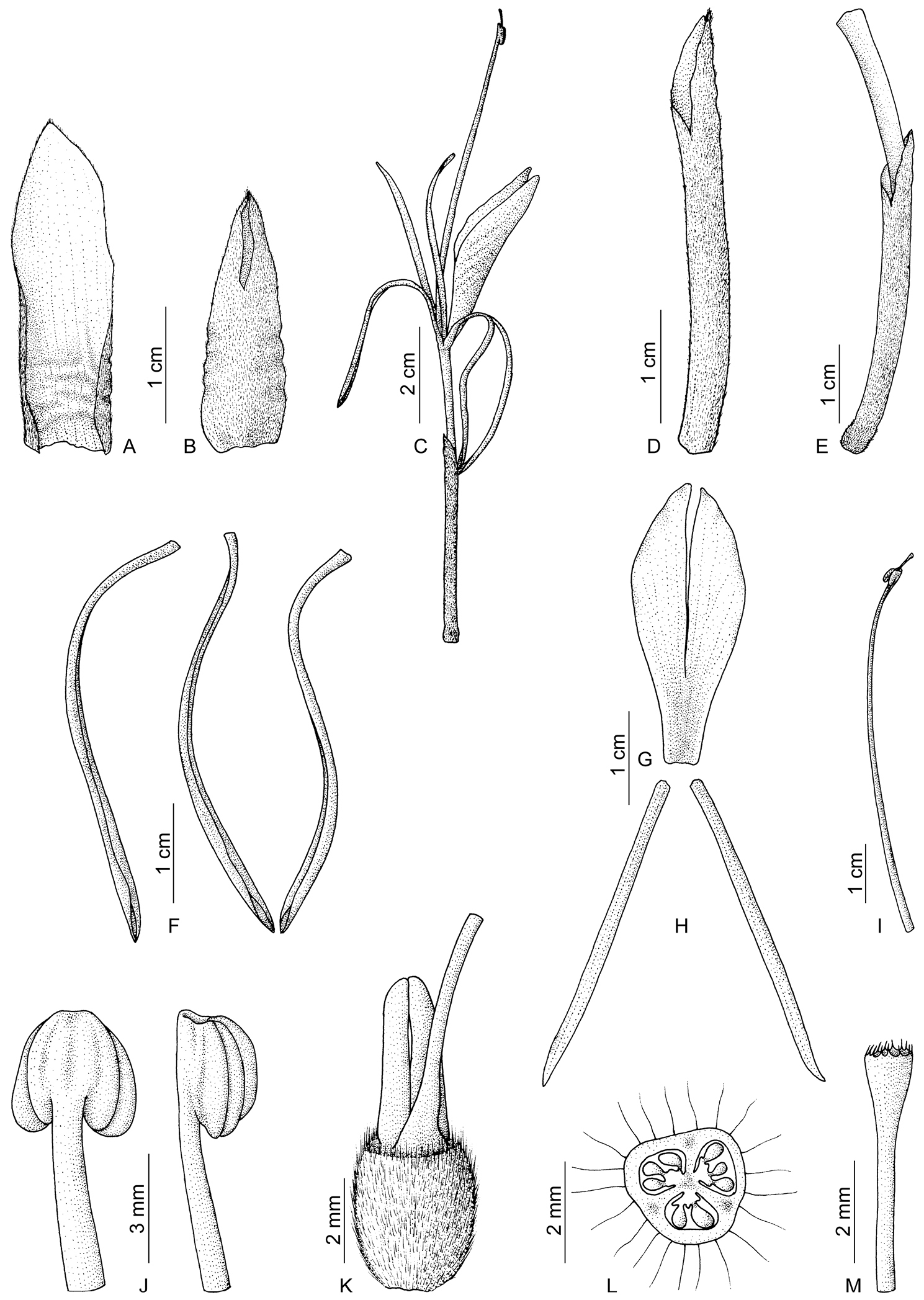






(C) 2013 Edakkandiyil Sanoj. This is an open access article distributed under the terms of the Creative Commons Attribution License 3.0 (CC-BY), which permits unrestricted use, distribution, and reproduction in any medium, provided the original author and source are credited.
For reference, use of the paginated PDF or printed version of this article is recommended.
Citation: Sanoj E, Sabu M, Pradeep AK (2013) Circumscription and lectotypification of Hedychium villosum and its variety H. villosum var. tenuiflorum (Zingiberaceae). PhytoKeys 25: 75–85. doi: 10.3897/phytokeys.25.4113
The nomenclatural confusion between the Indian gingers Hedychium villosum Wallich and its variety H. villosum var. tenuiflorum (Wall. ex Voigt) Wall. ex Baker is discussed. Both taxa are lectotypified in order to stabilize the names and contribute towards a resolution of their confusing nomenclatural past. Both taxa are described in detail to aid identification.
Gingers, India, nomenclature, typification, Nathaniel Wallich, Zingiberaceae
Zingiberaceae are one among the ten largest monocotyledonous families in India, represented by 20 genera and about 200 species, and are mainly concentrated in the Northeastern, Peninsular and Andaman and Nicobar regions. Hedychium, commonly called “ginger lily” or “butterfly lily” produces one of the most beautiful and aromatic flowers in the family Zingiberaceae. The genus Hedychium was established by
Whilst revising the species of Hedychium in India, nomenclatural and circumscription problems were encountered in relation to two plant names coined by Nathaniel Wallich, Hedychium villosum Wall. and its variety, Hedychium villosum var. tenuiflorum (Wall. ex Voigt) Wall. ex Baker. The plants of these two taxa are very peculiar in their sagittate anthers and winter flowering (December to April), whereas in other Indian species of Hedychium the anthers are oblong and plants flower during the monsoon season (June through October). For a long time, Hedychium villosum was identified as Hedychium villosum var. tenuiflorum or vice-versa or the two taxa were even lumped as a single highly variable species. As a result of extensive studies of the literature, herbarium and live specimens, we are now able to identify and delimit these two taxa, and recognize them as distinct. The variety differs in its shorter inflorescence, larger white flowers and larger anthers (see Table 1, Figs 1A, B). Confusion over taxon identity was in part caused by poor knowledge of the types of these names.
Type specimens: A Hedychium villosum Wall. - Sylhet, 1815, M. R. Smith s.n. pro parte (middle specimen; BM000574696) B Hedychium villosum var. tenuiflorum (Wall. ex Voigt) Wall. ex Baker- Botanic Garden Calcutta, originally from Sylhet, N. Wallich 6545C (BM).
Main morphological differences between Hedychium villosum and Hedychium villosum var. tenuiflorum.
| Characters | Hedychium villosum | Hedychium villosum var. tenuiflorum |
|---|---|---|
| Inflorescence | 16.5–33 cm long | 8.4–12.3 cm long |
| Flowers | 4.7–5.2 cm long, pale yellow | 11.8–12.2 cm long, white |
| Calyx | 1.6–1.8 cm long | 3.3–3.7 cm long |
| Corolla tube | 1.9–2.1 cm long, densely pubescent externally | 5–5.2 cm long, glabrous externally |
| Corolla lobes | 1.5–1.7 cm long, lower half pubescent externally | 4–4.4 cm long, glabrous externally |
| Lateral staminodes | 1.3–1.5 × c. 0.15 cm | 3.3–3.5 × 0.1–0.15 cm |
| Labellum | 1.3–1.4 × c. 0.5 cm | 3.1–3.5 × 1.2–1.5 cm |
| Filament | 2.4–2.6 cm long | 5.3–6.3 cm |
| Anther | c. 1.5 × 1.5 mm | c. 3.5 × 2.5–3 mm |
Hedychium villosum was originally described by Wallich (in
A few years later, Roscoe (1827) while treating ‘Monandrian Plants of the order Scitamineae’, accepted Wallich’s broad view and did not recognise any infraspecific taxa under Hedychium villosum. It is evident from his observation, “the chief diversity we have observed between our plant and that described in the ‘Flora Indica’, is in the downy margin and mid-rib of the leaves, and in the colour of the flowers, which in the ‘Flora Indica’ are described as of a pale yellow colour, whilst in ours they are a pure white”, that he had not recognized any taxa at intraspecific level probably for the reason that the sagittate anther peculiar to Hedychium villosum is also present in the other element (Wallich’s “tenuiflorum”). He stated further that, “Dr. Wallich has also communicated another species under the name Hedychium tenuiflorum, which resembles the present, as well in the deep-lobed, undulated lip, as in the small sagittateanther.....”. Interestingly, the description and figure provided by Roscoe (1827, t. 54) under the name Hedychium villosum are an excellent match for ‘var. tenuiflorum’ (sensu the specimen Wallich 6545C), not for Hedychium villosum (sensu
During herbarium studies of Wallich material we were unable to locate material identifiable as Hedychium villosum in the original Wallich herbarium at Kew. However, at BM we located one specimen collected from Sylhet in 1815 that corresponded to that cited by Roxburgh and Wallich. The label on this specimen is in Wallich’s hand. Although the specimen lacks a collector name, we infer from the protologue that it was collected by M.R. Smith. It is mounted with another two plant fragments, the right hand material corresponds to Hedychium villosum var. tenuiflorum and other the central and left hand specimens match what is currently understood as Hedychium villosum. Hence, from the elements on this sheet, the middle plant fragment is selected and designated here as the lectotype of Hedychium villosum. Because
India. “Sylhet”, 1815, M. R. Smith s.n. pro parte (middle specimen) (lectotype, designated here: BM! [BM000574717, middle stem only]). Figs 1A, 2.
Epiphytic perennial herbs. Leafy shoots 60–90 cm high, erect, slender. Leaves 8–12 in number, spreading, at a distance of 3.4–7.5 cm, sessile; sheath 1.9–2 cm wide, puberulent at margins; ligule 1.8–2.1 × 0.7–0.8 cm, single-lobed, oblong, membranous, puberulent externally, tip acute; lamina 14–20 × 3.7–4.5 cm, elliptic-lanceolate, dark green and glabrous above, pale green and puberulent below; midrib pubescent below; tip long acuminate; base obtuse; margin non-ciliate, translucent, white tinged. Inflorescence 16.5–33 cm long, erect or drooping, lax, cylindrical. Bract 1.2–1.4 × 0.4–0.5 cm, one on each flower, convolute, elliptic, boat-shaped, brown, non-tubular, more or less leathery, densely hairy externally, hairs brown; margin non-ciliate; cincinnus 2–3 -flowered. Bracteoles 1–1.3 × c. 0.25 cm, brown, tubular, unilaterally split upto 5–8 mm, densely hairy externally, hairs brown; margin non-ciliate. Flower 4.7–5.2 cm long, pale yellow, highly fragrant, many open at a time. Calyx 1.6–1.8 × c. 0.15 cm, tubular, unilaterally split up to 5–6 mm, gradually convolute towards the tip, membranous, translucent, densely pubescent externally; hairs brown; obscurely 3 -lobed at tip. Corolla tube 1.9–2.1 cm long, c. 1.5 mm wide at mouth, straight, exceeding the calyx and bract, pale yellow, densely pubescent externally, hairs brown, hairy internally. Corolla lobes oblong, pale yellow, lower half pubescent externally, glabrous on upper half, margins non-ciliate, non-beaked at tip, lobes 3-nerved; dorsal lobe 1.6–1.7 × c. 0.15–0.2 cm long; lateral lobes 1.5–1.6 × c. 0.15 cm long. Lateral staminodes 1.3–1.5 × c. 0.15 cm, linear, straight, pale yellow, tip acute. Labellum 1.3–1.4 × c. 0.5 cm, elliptic, narrow towards base, pale yellow, sinus 0.8–0.9 cm deep, lobes tip acute; claw c. 1 mm wide at base. Stamen 2.6–2.8 cm long. Filament 2.4–2.6 cm long, scarlet, straight, c. 0.5 mm wide at base. Anther c. 1.5 × 1.5 mm, sagittate, brown, glabrous, non-crested, pink, truncate at tip, glabrous. Ovary c. 3 × 2 mm, oblong, pale green, densely pubescent externally. Style filiform, white, glabrous. Stigma cup-shaped, margin ciliate, c. 0.5 mm exserted from anther. Epigynous glands two, 2.5–3 mm long, oblong. Fruits unknown.
Hedychium villosum Wall. A bract B bracteole C single flower D calyx E corolla tube with calyx and ovary F corolla lobes G labellum H lateral staminodes I stamen J anther, back view (left) and front view (right) K ovary with epigynous glands and base of style L cross section of ovary M stigma with a part of style. Line drawing by E. Sanoj; voucher M. Bhaumik 1922 (CAL).
Bangladesh, China, India and Myanmar from 660 to 1400 m (
INDIA. Arunachal Pradesh: Changlang Dt.: Chenglang to Khela, 666.6 m, 12 Mar 1958, G.K. Murthy 12939 (ASSAM); Dibang Valley Dt.: Thewarygaon, 1200 m, 20 May 1998, M. Bhaumik 1922 (CAL); Anini, 1640 m, M. Bhaumik s.n. (CAL); Mehao Lake, 1300 m, 1 Dec 1996, M. Bhaumik & M.K. Pathak 1153 (CAL); 1200 m, 20 May 1998, M. Bhaumik & M.K. Pathak 1902 (CAL); West Siang Dt.: Nokka to Nagminu, 5 Jul 1961, D.B. Deb 26547 (ASSAM); Meghalaya: Khasia, 4000 ft, J.D. Hooker & J. Thomson s.n. (K), Khasia No. 6 (CAL); Mizoram: Aizwal Dt.: Sialsuk, Lushai Hills, 4700 ft, 15 Jan 1963, D.B. Deb 30713 (ASSAM); Lunglei Dt.: Theiriat, Lushai Hills, 25 Jan 1963, D.B. Deb 31265 (ASSAM); Serchip Dt.: Kheitum, Lushai Hills, 23 Jan 1963, D.B. Deb 31185 (ASSAM); Locality unknown. Mack s.n. (K), Griffith s.n.
India. Botanic Garden of Calcutta, originally from Sylhet, N. Wallich 6545C (lectotype, designated here: BM!) Figs 1B, 3.
Epiphytic perennial herbs. Leafy shoots 66–70 cm high, slanting or erect. Rhizomes 1.7–3 cm wide, pale green internally, slightly aromatic. Roots 0.6–12 mm wide, velamen type. Leaves 5–10 in number, at a distance of 4–8.5 cm, sessile; sheath 1.9–2 cm wide, green, margins pink, pubescent externally; ligule 2.9–3.4 × 1.3–1.6 cm, single-lobed, oblong, pale pink, densely pubescent externally, tip acute, margins and tip brown, early dried off; lamina 34–40 × 8–9 cm, elliptic-lanceolate, dark green above, pale green below, glabrous; midrib pubescent below, becomes glabrous towards tip; tip long acuminate; base obtuse; margin non-ciliate, translucent, pale pink tinged. Inflorescence 8.4–12.3 cm long, erect, lax, cylindrical. Bract 2.7–2.9 × 1.1–1.2 cm, one on each flower, convolute, lanceolate, boat-shaped, brown, non-tubular, leathery, easily dried before flowering, densely hairy or villose externally, hairs brown; margin ciliate towards tip; cincinnus 3–4 -flowered. Bracteoles 2.1–2.2 × 0.7–0.75 cm, lanceolate, brown, tubular, unilaterally split upto 9–10 mm, somewhat leathery, densely hairy or villose externally, hairs brown; margin ciliate towards time. Flower 11.8–12.2 cm long, white with red stamen, mildly fragrant, three-many opens at a time. Calyx 3.3–3.7 × 0.2–0.3 cm, pale green, pink tinged towards tip, tubular, unilaterally split up to 5–9 mm, lower 2/3 portion closely appressed to corolla tube, membranous, translucent, densely pubescent externally; tip easily dried while flowering, obscurely 2 or 3 -lobed. Corolla tube 5–5.2 cm long, 2–2.5 mm wide at mouth, straight, exceeding the calyx and bract, creamy white, translucent towards base, glabrous externally, hairy internally. Corolla lobes oblong, greenish white, glabrous, drooping from flower; tip non-pouched, margins non-ciliate, lobes 3-nerved; dorsal lobe 4.3–4.4 cm long; lateral lobes 4–4.1 cm long. Lateral staminodes 3.3–3.5 × 0.1–0.15 cm, linear, straight, linear, white with a slight yellow tinge at base; tip acute, rarely forked. Labellum 3.1–3.5 × 1.2–1.5 cm, oblanceolate, boat-shaped, white with a yellow tinge at base, sinus 1.9–2.2 cm deep, lobes ensiform, unequal; claw 4–4.5 mm wide at base. Stamen 5.8–6.5 cm long. Filament 5.3–6.3 cm long, straight, c. 1.5 mm wide at base, red, light red towards tip. Anther c. 3.5 × 2.5–3 mm, sagittate, brown, glandular hairy; connective red, glabrous, row of hairy at margin, tip prolonged in to a crest; crest c. 1 mm long, red, truncate or slightly notched at center, glabrous. Ovary 2.5–3 × 2–2.5 mm, barrel-shaped, pale green, densely pubescent externally. Style filiform, white, glabrous, pale pink spotted towards stigma. Stigma cup-shaped, margin ciliate, 2–5 mm exserted from anther. Epigynous glands two, 3.5–5.5 mm long, oblong-lanceolate, yellow, free at base, fused towards tip. Fruits 1–1.1 × 1–1.1 cm, globular, sericeous, slightly angular.
Hedychium villosum var. tenuiflorum (Wall. ex Voigt) Wall. ex Baker. A bract B bracteole C single flower D calyx E corolla tube with calyx and ovary F dorsal and lateral corolla lobes G labellum H lateral staminodes I stamen J anther, back view (left) and lateral view (right) K ovary with epigynous glands and base of style L cross section of ovary M stigma with a part of style. Line drawing by E. Sanoj; voucher E. Sanoj 95619 (CALI).
Northeastern India, Bangladesh, northern Myanmar, southern Yunnan and Guangxi provinces of China, Thailand, Vietnam, and Malaysia from 600 to 1800 m (
INDIA. Arunachal Pradesh: Changlang Dt.: Wakka to Nagminu, 5 Jul 1961, D.B. Deb 26547 (ASSAM, CAL); Chenglang to Khela, 666.6 m, 12 Mar 1958, G.K. Murthy 12939 (ASSAM, CAL); Dibang Valley Dt.: Delei Valley, 28°21'N, 96°37'E, 14 Jul 1928, F.K. Ward 8448 (K); EAST SIANG Dt.: Rengging, Flora of Abor expedition, 24 Feb 1912, J.H. Burkill 36708 (CAL); Lohit Dt.: Dreyi above Denning, 28°10'N, 96°15'E, 2000–4000 ft, 5 Mar 1928, F.K. Ward 7916 (K); Forest around Hayuliang along Dalai River, 13 Jan 1970, J. Joseph 48932 (ASSAM); Assam: Kamrup Dt.: Golaghat Dt.: Jabocka, Naga Hills, 6000 ft, Mar 1899, Prain’s Collector 99 (CAL); Lakhimpur Dt.: Kakopathar, 23 Feb 1947, M.M. Srinivasan 21955 (ASSAM); Manipur: s.loc., 22 Jan 1953, D. Deb 682 (CAL); Koupia N.W. range, 4-6000 ft, 10 Feb 1882, G. Watt 5844 (CAL, E, K); Imphal Dt.: Kauglatonghi, s.coll. 10815 (K), 3000 ft, Feb 1906, A. Meebold 10815 (CAL), 3500 ft, 5 Mar 1946, J. Hake 980 (K); Meghalaya: Khasia, 4000 ft, J.D. Hooker & J. Thomson s.n. (K), s.loc. 1845, Griffith 45 (K), s.loc. 5000 ft, 1878, Geo. Gallatly 108 (CAL), Native collectors of Bot. Garden Calcutta s.n. (E), 5–6000 ft, Feb 1906, A. Meebold 5179 (CAL), 8 Mar 1921, U. Kanjilal 7660 (ASSAM); East Khasi Hills Dt.: Baedon Falls, Shillong, 22 Mar 1892, D. Prain 43 (CAL); Pynursla forest, 18 Oct 1938, R.N. De & D.C. Forests 19615 (ASSAM); Mawrynklang, near Wattle Plantation, 27 Jan 1957, G.K. Deka 5232 (ASSAM, CAL); Mawswai, K&J Hills, 1200 m, 26 Mar 1960, G. Panigrahi 21338 (ASSAM); Woodlands, 11 Mar 1966, D.M. Verma 36862 (ASSAM); Barapani, 5000 ft, Geo Gallatly 108 (K); Jorain, 1580 m, 13 Aug 2004, E. Sanoj 95619 (CALI); Jaintia Hills Dt.: Lumsnong, 4 Jan 1958, A. Sanyal 9 (CAL); West Khasi Hills Dt.: Nongstoin village, 9 Mar 1972, P.C. Pant 51483 (ASSAM); Mizoram: Zopui-Tlang, 1332 m, 22°50'83.2"N, 092°48'80.5"E, 07 Sep 2002, M.G. Prasanth Kumar & Jana Leong-Škorničková 86213 (CALI); Lunglei Dt.: Near Fort Lungleh, 3-4000 ft, Apr 1899, A.T. Gage 120 (CAL); Lushai Hills, Darzo, 5000 ft, Jan 1928, N.E. Parry 581 (K); Nagaland: Naga Hills, Pipluma, 1 Mar 1882, s.coll. 158 (CAL), Naga hills, Jun 1935, N.L. Bor 21217 (ASSAM), Jisi, 5000 ft, 6 Mar 1955, N.L. Bor 2871 (K); Kohima Dt.: Tseminyu forest-Wokha Road, 12 Apr 1975, Chandra Bahadur 61794 (ASSAM); Tuensang Dt.: 5 Km from Noklak, 20 May 2007, V.P. Thomas & V.A. Muhammed Nissar 103700 (CALI); Locality unknown. Mack s.n. (K); C.B. Clarke s.n. (K); Hooker & Thomson 6545 (K); N.E. Parry s.n. (CAL); Griffith s.n. (CAL).
In 1890, probably following Roscoe (1827), C.B. Clarke annotated two herbarium sheets at Kew, each of which is a single sheet with two specimens mounted on it. He determined the left hand specimens of both sheets (K000640488! and K000640489!) bearing long cylindrical inflorescences and rather small flowers and anthers as ‘var. tenuiflorum Wall.’, and the right hand specimens (K000640486! and K000640487!) bearing rather large flowers and anthers as Hedychium villosum. It appears that subsequent authors (Baker 1892;
We would like to acknowledge K.N. Gandhi, Harvard University for help in solving the nomenclatural confusion and assistance in preparing the manuscript. We also thank J.F. Veldkamp, Leiden, The Netherlands; Tom Wood, University of Florida, USA; John McNeill, Royal Botanic Garden, Edinburgh; V.P. Prasad, Indian Liaison Officer, Kew for help and contributions to our understanding of these two taxa and Dr. M. Sanjappa, Director, Botanical Survey of India for the loan of herbarium specimens. Funding support was provided by a research grant from the Department of Science and Technology, Govt. of India, New Delhi (SP/SO/PS/115/2009), Senior Research Fellowship awarded by the Council of Scientific and Industrial Research (CSIR), New Delhi, (9/43(0138)2K9-EMR-I) and an IAPT Research Grant (2011); all are gratefully acknowledged.


